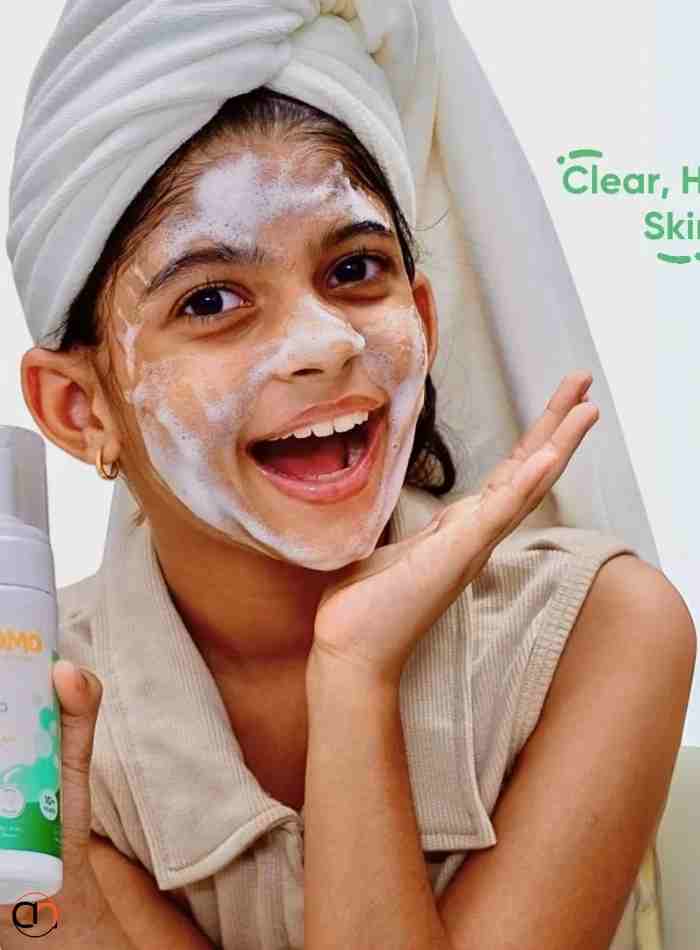When it comes to taking care of your child’s skin, it’s easy to assume that their skin is naturally soft and healthy, and that it requires little attention. However, the reality is that children’s skin is much more delicate and sensitive than adults’ skin. From the moment they are born, their skin goes through a series of changes and adjustments, making it vital to provide proper care.
Whether you are a new parent or a seasoned caregiver, understanding the basics of kids’ skincare can help you prevent skin irritations, allergies, and other common issues.
In this blog post, we’ll explore Kids Skin Care that will ensure your little one’s skin stays healthy, protected, and well-nourished.
Why Kids’ Skin Needs Special Care:
Children’s skin is thinner and more sensitive than that of adults. At birth, a baby’s skin is about 40% thinner than an adult’s, making it more prone to damage from environmental factors such as sunlight, pollutants, and harsh chemicals. Additionally, the skin’s barrier function (the protective layer that keeps moisture in and harmful substances out) is still developing in young children, making them more vulnerable to dryness, irritation, and infections.
A child’s skin also reacts differently to products and conditions, so it’s important to use gentle, age-appropriate skincare. In the early years, your child’s skin may undergo a variety of changes, including reactions to the introduction of solid foods, exposure to allergens, and even the change of seasons. By giving extra attention to their skincare needs, you can support the development of their skin barrier and avoid common skin problems such as rashes, eczema, and acne.
Best Kids Skin Care Tips:
1. Gentle Cleansing: The Foundation of Skincare
The first step in any skincare routine, especially for kids, is gentle cleansing. Soap can be harsh on young skin, stripping it of its natural oils, which can lead to dryness, irritation, and discomfort. It’s essential to choose the right cleanser that’s formulated for children’s delicate skin.
-
Use a Mild, Fragrance-Free Cleanser: Choose a baby or children’s cleanser that’s free of fragrances, dyes, and harsh chemicals. Look for a product that’s hypoallergenic and dermatologically tested to avoid potential skin reactions.
-
Avoid Hot Water: While it might be tempting to give your child a warm bath, hot water can dry out the skin. Always use lukewarm water to avoid stripping moisture from the skin. Limit bath time to 10-15 minutes, as prolonged exposure to water can dry the skin out.
-
Gently Pat the Skin Dry: After bath time, avoid rubbing the skin with a towel. Instead, gently pat the skin dry with a soft towel to preserve moisture.
2. Moisturizing: Keeping the Skin Hydrated
Moisturizing is a crucial step in kids’ skincare, as it helps to lock in moisture and prevent dryness. A child’s skin is particularly susceptible to losing moisture, especially after a bath or during dry weather.
-
Choose a Nourishing Moisturizer: Pick a gentle, fragrance-free moisturizer that is rich in nourishing ingredients like shea butter, aloe vera, or glycerin. These ingredients help hydrate and protect the skin without causing irritation.
-
Moisturize Immediately After Bathing: The best time to apply moisturizer is immediately after bath time, while the skin is still slightly damp. This helps to lock in moisture and create a protective barrier.
-
Apply Throughout the Day: In addition to applying moisturizer after a bath, it’s important to moisturize your child’s skin daily, especially during winter months when skin tends to dry out more quickly.
3. Sun Protection: Shielding Your Child’s Skin from UV Damage
Children are especially vulnerable to sunburns and long-term sun damage, as their skin has less melanin, the natural pigment that protects against harmful UV rays. Sun exposure during childhood can increase the risk of skin cancer later in life, so it’s crucial to protect your child’s skin from the sun’s harmful rays.
-
Use a Broad-Spectrum Sunscreen: Always apply a broad-spectrum sunscreen with an SPF of at least 30 or higher to your child’s exposed skin. Choose a sunscreen that is water-resistant and free of chemicals like oxybenzone, which can irritate sensitive skin.
-
Apply Sunscreen Generously: Be sure to apply sunscreen 15 to 30 minutes before going outside. Don’t forget areas like the back of the neck, ears, and tops of the feet. Reapply sunscreen every two hours, or more frequently if your child has been swimming or sweating.
-
Dress in Protective Clothing: In addition to sunscreen, dress your child in protective clothing, such as wide-brimmed hats, long-sleeved shirts, and pants. Use sunglasses to protect their eyes from UV rays.
-
Seek Shade: Whenever possible, try to keep your child in the shade during peak sun hours (usually between 10 a.m. and 4 p.m.). This is especially important for babies and toddlers who have more sensitive skin.
4. Treating Common Skin Conditions in Kids
Even with the best skincare routine, kids can still experience skin conditions, from dry skin to rashes and eczema. Here are some common skin issues that children may face and how to manage them:
Dry Skin
Dry, flaky skin is common in children, especially during the colder months when the air is dry. To prevent dry skin:
-
Increase Moisturizing: If your child has dry skin, be sure to moisturize them more frequently throughout the day.
-
Use a Humidifier: In dry indoor environments, consider using a humidifier in your child’s room to maintain moisture in the air.
Eczema
Eczema, or atopic dermatitis, is a common skin condition in children, characterized by red, itchy patches on the skin. To manage eczema:
-
Use a Fragrance-Free Moisturizer: Moisturizing is key to controlling eczema. Use a thick, emollient moisturizer and avoid lotions with alcohol or fragrances.
-
Apply Topical Steroids: For flare-ups, your pediatrician may recommend a mild corticosteroid cream. Always use as prescribed.
Rashes
Rashes, such as diaper rashes, heat rashes, or contact dermatitis, can occur from irritation or allergic reactions. Here’s how to treat them:
-
Keep Skin Clean and Dry: Rashes often develop when the skin is kept in a damp or dirty environment. Ensure your child’s skin is clean and dry to prevent further irritation.
-
Use Gentle, Non-Irritating Products: Avoid using products with fragrances or harsh chemicals on areas affected by rashes.
Acne
Though rare in young children, some kids can experience acne, particularly as they approach puberty. While acne is often more common in teenagers, it can occur in younger kids, especially if they have oily skin or if their hormones are fluctuating.
-
Use a Gentle Face Wash: For kids experiencing acne, use a mild, soap-free face wash that doesn’t strip the skin. Avoid harsh scrubbing, as this can irritate the skin and worsen acne.
-
Consult a Pediatrician: If acne persists, consult a pediatrician or dermatologist for appropriate treatment options.
5. Healthy Lifestyle: Diet and Hydration for Skin Health
The health of your child’s skin also depends on what they put inside their body. A balanced diet rich in vitamins and minerals plays a crucial role in maintaining healthy skin.
-
Hydrate: Encourage your child to drink plenty of water to keep their skin hydrated from the inside. Dehydration can lead to dry and flaky skin.
-
Eat Skin-Friendly Foods: Foods rich in vitamins A, C, and E, such as fruits, vegetables, and whole grains, can help nourish the skin. Omega-3 fatty acids found in fish and seeds also promote healthy skin.
6. The Importance of Regular Skin Checks
As your child grows, it’s important to monitor their skin for any changes. Keep an eye on moles, blemishes, or any unusual skin growths. If you notice anything concerning, don’t hesitate to consult a healthcare provider. Early detection of skin conditions, like skin cancer, can lead to better outcomes.
Find More: Skin Advice Aesthetic
Last Call:
Proper skincare for kids is more than just about keeping their skin soft and smooth; it’s about protecting their skin from harmful irritants, allergens, and environmental factors. By establishing a gentle skincare routine, using sun protection, treating common skin conditions, and encouraging a healthy lifestyle, you can ensure your child’s skin stays healthy, comfortable, and happy.
Remember, always consult a pediatrician or dermatologist if you have concerns or if your child’s skin shows signs of irritation, allergies, or other skin conditions. With the right care, your child’s skin will stay in top shape throughout their childhood and beyond.
FAQs:
Q. How can I keep my child’s skin moisturized?
Use a gentle, fragrance-free moisturizer immediately after bathing to lock in moisture. Apply it throughout the day, especially during dry weather.
Q. What is the best sunscreen for kids?
Choose a broad-spectrum sunscreen with SPF 30 or higher, free from harsh chemicals like oxybenzone. Opt for water-resistant formulas for better protection.
Q. How can I treat my child’s dry skin?
Increase moisturizing frequency, use lukewarm water for baths, and consider using a humidifier in dry indoor environments to prevent skin from drying out.
Q. What can I do if my child has eczema?
Use fragrance-free moisturizers, apply mild topical steroids as prescribed by a pediatrician, and avoid triggers like harsh soaps and chemicals.
Q. How often should I apply sunscreen to my child?
Apply sunscreen 15-30 minutes before sun exposure and reapply every two hours, or more frequently if your child is swimming or sweating.



